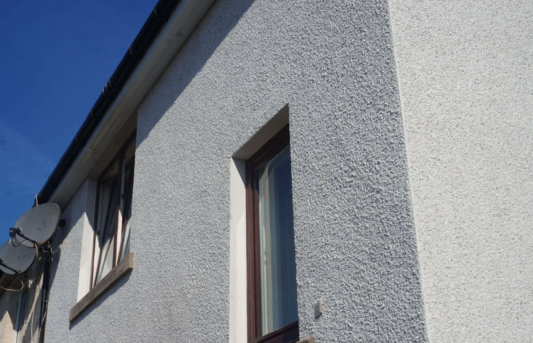Roughcasting is a technique in which stones are mixed with mortar and thrown against the wall with force. You can choose from a range of roughcast colours Scotland.
The final result is a more durable finish and better adhesion. While smooth casting is easier to work with, roughcasting has its advantages. It has a uniform colour and a softer visual feel.

What is Roughcasting?
Roughcasting is a type of exterior plastering used on the lower section of a wall or as a finishing layer over another exterior plaster finish. Roughcasting makes use of lumps, bumps, and grooves to give brickwork a rough and textured appearance. These irregularities help hide imperfections in the surface below and create a more natural look.
If you have ever seen an old cottage with a finished wall that looks like it has been made from cement rather than bricks, you will have seen roughcast. It’s an old technique that’s coming back into fashion because of its authentic appearance and ability to conceal faults in the surface beneath it.
Roughcast is a traditional and cost-effective way of adding external cladding to a building. It is also known as cob, Dutch finish or cobb walling. Roughcast has been used for centuries as an affordable and durable material for exteriors. There are also environmental benefits of using roughcast, because it can be applied directly over existing walls without the need to remove any old plaster, saving on time and money. If you’re thinking about installing roughcast on your property, read this article first.
Pebbledash
Pebbledash is an attractive finish for exterior walls. It is made of small pebbles dredged from the sea bed, which have been washed to remove water. It is a very durable material, but it must be carefully maintained. If not, it can look worn, with cracks, hollow render, and missing pebbles. Pebbledash is not everyone’s cup of tea. Many people believe that the only option is to repaint the walls. However, this technique is not as durable as standard masonry paint.
Pebbledash is a modern variation of the ancient Roman rendering process. It is a mixture of lime and sand applied to the external walls to produce a stippled look. It is believed to have originated in the 16th century in East Anglia, where it was used to cover messy stones. Today, pebbledash is applied to exterior walls using a polymer-cement mortar, which offers a wide range of roughcast colours Scotland in addition to finishes.
Harling
Harling roughcasting benefits and types vary depending on its purpose. The process uses dry shingles and pebbles, which are then cast into a wet adhesive coat. During dubbing out, the wall faces should be dubbed out evenly. This process creates a uniform wall thickness that contributes to the final appearance and performance of the work.
Harling roughcasting is the most traditional form of surface finish in Scotland. It is also known as a wet dash in Ireland and the south. It provides a protective, weatherproof surface for many traditional buildings. While harling is less durable than solid-wall buildings, it can still last for centuries without maintenance.
Harling roughcast
Achieving consistent thickness for a harled finish can be challenging. Traditional methods rely on hand troweling and dashing against a wall. However, a forehand or backhand casting technique can help you achieve an even thickness. This technique can also help you reach awkward or hard-to-reach areas. Traditional harled finishes feature texture, pattern, and pattern thickness variations, which may depend on the tradesperson’s preference.
The traditional Scottish surface finish, harling, consists of lime and aggregate. The material has a rough texture renowned for protecting against the wet Scottish climate. This type of finishing is also used in modern buildings. It has many benefits, including the fact that it eliminates the need for paint.
Smooth casting
Historically, roughcasting has been used for several purposes, including climatic reasons and to conceal shoddy artistry. It was typically used on outbuildings and ordinary buildings and panels on timber-framed buildings. Today, it is more commonly used for home improvements on urban terraces. It offers several advantages over smooth rendering, including a uniform colour and a soft visual finish.
This process is highly cost-effective for high-volume production runs, especially if a part’s a relatively low thickness. However, it is challenging to guarantee minimum mechanical properties and is unsuited for high-pressure applications like hydraulic systems. Also, the process limits the maximum size of a cast part.
Gypsum plaster
There are two general types of roughcasting: one coat and two coats. The former is thicker and is used to create layers that last longer than the second. This type of roughcasting is generally applied by hand, although some professionals use mechanical tools to even out the surface of the plaster.
There are benefits and drawbacks to both types of roughcasting. Each has different strengths and weaknesses, so consider the specific situation before choosing one. For example, roughcasting can be difficult on buildings with a lot of dampness. This plaster can be used for finishing but should not be used for load-bearing applications. It is best to use a support framework underneath such cases.

A film critic and entertainment writer, Daniel explores acting techniques, movie industry trends, and in-depth film analyses.





